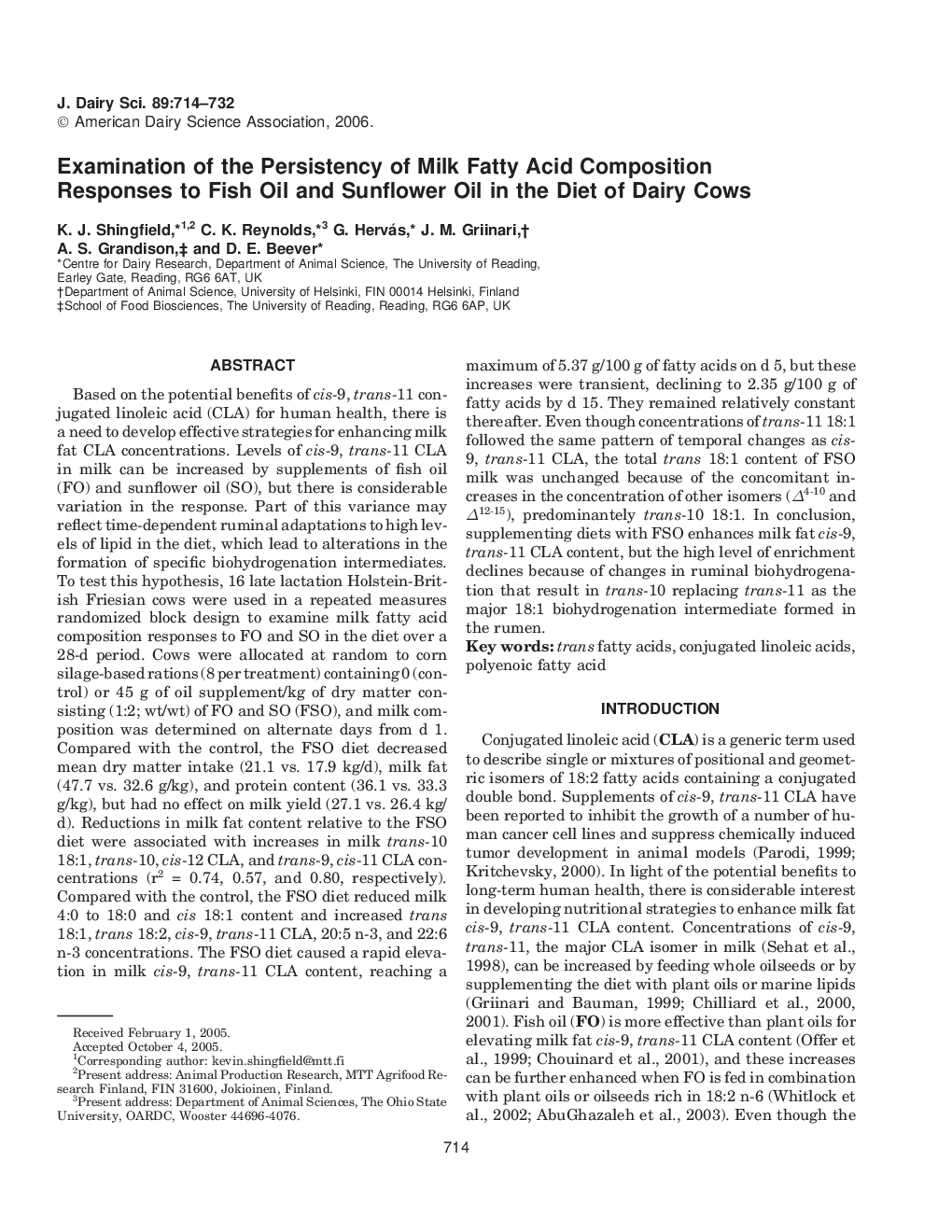| کد مقاله | کد نشریه | سال انتشار | مقاله انگلیسی | نسخه تمام متن |
|---|---|---|---|---|
| 2441225 | 1108134 | 2006 | 19 صفحه PDF | دانلود رایگان |
عنوان انگلیسی مقاله ISI
Examination of the Persistency of Milk Fatty Acid Composition Responses to Fish Oil and Sunflower Oil in the Diet of Dairy Cows
دانلود مقاله + سفارش ترجمه
دانلود مقاله ISI انگلیسی
رایگان برای ایرانیان
کلمات کلیدی
موضوعات مرتبط
علوم زیستی و بیوفناوری
علوم کشاورزی و بیولوژیک
علوم دامی و جانورشناسی
پیش نمایش صفحه اول مقاله

چکیده انگلیسی
Based on the potential benefits of cis-9, trans-11 conjugated linoleic acid (CLA) for human health, there is a need to develop effective strategies for enhancing milk fat CLA concentrations. Levels of cis-9, trans-11 CLA in milk can be increased by supplements of fish oil (FO) and sunflower oil (SO), but there is considerable variation in the response. Part of this variance may reflect time-dependent ruminal adaptations to high levels of lipid in the diet, which lead to alterations in the formation of specific biohydrogenation intermediates. To test this hypothesis, 16 late lactation Holstein-British Friesian cows were used in a repeated measures randomized block design to examine milk fatty acid composition responses to FO and SO in the diet over a 28-d period. Cows were allocated at random to corn silage-based rations (8 per treatment) containing 0 (control) or 45Â g of oil supplement/kg of dry matter consisting (1:2; wt/wt) of FO and SO (FSO), and milk composition was determined on alternate days from d 1. Compared with the control, the FSO diet decreased mean dry matter intake (21.1 vs. 17.9Â kg/d), milk fat (47.7 vs. 32.6Â g/kg), and protein content (36.1 vs. 33.3Â g/kg), but had no effect on milk yield (27.1 vs. 26.4Â kg/d). Reductions in milk fat content relative to the FSO diet were associated with increases in milk trans-10 18:1, trans-10, cis-12 CLA, and trans-9, cis-11 CLA concentrations (r2Â =Â 0.74, 0.57, and 0.80, respectively). Compared with the control, the FSO diet reduced milk 4:0 to 18:0 and cis 18:1 content and increased trans 18:1, trans 18:2, cis-9, trans-11 CLA, 20:5 n-3, and 22:6 n-3 concentrations. The FSO diet caused a rapid elevation in milk cis-9, trans-11 CLA content, reaching a maximum of 5.37Â g/100Â g of fatty acids on d 5, but these increases were transient, declining to 2.35Â g/100Â g of fatty acids by d 15. They remained relatively constant thereafter. Even though concentrations of trans-11 18:1 followed the same pattern of temporal changes as cis-9, trans-11 CLA, the total trans 18:1 content of FSO milk was unchanged because of the concomitant increases in the concentration of other isomers (Î4-10 and Î12-15), predominantely trans-10 18:1. In conclusion, supplementing diets with FSO enhances milk fat cis-9, trans-11 CLA content, but the high level of enrichment declines because of changes in ruminal biohydrogenation that result in trans-10 replacing trans-11 as the major 18:1 biohydrogenation intermediate formed in the rumen.
ناشر
Database: Elsevier - ScienceDirect (ساینس دایرکت)
Journal: Journal of Dairy Science - Volume 89, Issue 2, February 2006, Pages 714-732
Journal: Journal of Dairy Science - Volume 89, Issue 2, February 2006, Pages 714-732
نویسندگان
K.J. Shingfield, C.K. Reynolds, G. Hervás, J.M. Griinari, A.S. Grandison, D.E. Beever,